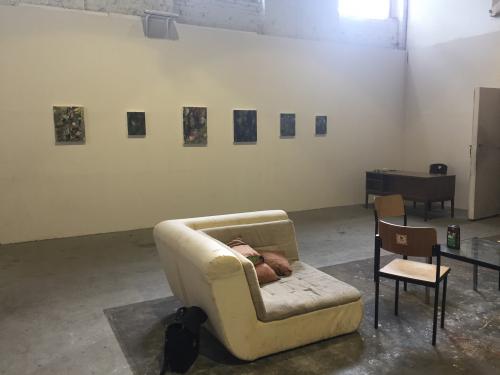This is the third post in the Play Out series, a collection of profiles on performers, ensembles, and organizations who have chosen non-traditional approaches to classical music performance. The previous post was about David Marton, a theatre and opera director whose musical background inspired him to transform musicians into characters onstage.
“I just really love classical music!” exclaimed Shasta Ellenbogen, violist and founder of the Classical Music Sunday series at Die Wiesenburg in Berlin. The chamber music series, which takes place every other week in a Wedding-district art space that seems straight out of the ‘90s Berlin squat scene, is her venture to make live classical music a fun and relaxed experience – a nice social evening out – rather than a stressful and judgmental formal occasion.
Shasta grew up in Canada, where going on a luxurious youth orchestra tour convinced her that being a classical musician “is probably a cool job.” Her subsequent experiences in the field, though, were largely negative. At 17, she went to study at a conservatory in Amsterdam, where she was seen as a promising talent, but her first teacher was cruel and the next was “the kind of teacher who had only hot girls in his class.” Anxious to leave, she quit the program and moved to London, where she continued studying with that second teacher, but she remained unhappy and her playing plummeted.
From then on, she vowed to never again enroll in a music school. She traveled a lot over the next few years, first to India for a teaching position at A.R. Rahman’s K.M. Conservatory, then briefly back to Canada, then to Portugal to perform in a regional orchestra, before finally settling in Berlin, where she lived off of pop gigs and the spoils from winning a competition in Ottawa. She refers to this as her “poor student artist” phase. At the time, rents in Berlin were cheap enough that she could work three days per month and spend the remaining hours at home, practicing Bach cello suites and violin partitas on her instrument. She was surprised to discover how helpful playing pop music was to her viola technique; the basic chord progressions of pop seemed to her like the simplest tension-release pattern of which Bach is “the height of evolution.” Suddenly, “Bach was not mysterious to me any more. It became instantly not hard.”
Around this time, an older theremin player happened across Shasta on youtube and invited her to join his improv band, and she took the plunge, despite lack of prior experience. She really enjoyed the people that she met on the improv circuit, since they were not “judgmental and uptight” like many classical musicians. She attempts to carry over this spirit of improvisation and spontaneity to classical performances at Die Wiesenburg, despite playing canonical repertoire from scores. “I think people can connect to that feeling much more easily than connecting to the feeling of this presented thing,” she explained.
After a while, she began to participate in a variety of projects around Germany that “try and make classical music cool.” However, she felt that most of these projects fell short for one reason or another. Some involved playing sub-par repertoire. Often, the performers were asked to do things that they are not good at, such as acting or singing, which resulted in an unprofessional show. Some efforts were just out of touch with what today’s young people consider hip and cool. The work was often extremely demanding for the musicians involved, and at the end, these peer musicians reflected on the performances with exactly the same judgmental attitude that Shasta was trying to escape. On top of all of this, she feels these projects were mostly only “cool for people who do already like classical music… But not for people who don’t.”
It became her dream to open a venue – a place where listening to classical music could be just like any other fun party, but without adding anything extra to the music itself. When she came across the space at Die Wiesenburg, it seemed like a dream come true. She can use the space for free, which makes it like having a venue of her own but without all of the headaches that come with managing a space. The musicians send around a hat for donations, but since there is no other funding source to pay them, they have only a single rehearsal before the performance – something that also takes off some of the pressure and ensures more spontaneity, according to Shasta. “It’s non-judgmental. It’s also about opening up to each other, on a deeper level than usual, for a gig.”
When I attended a concert at Die Wiesenburg in July, the audience was diverse, ranging from teens to a 90-year-old woman and including two dogs who really did not like each other and needed to be physically restrained at various times during the concert. Shasta says that many of these attendees are regulars, including several who live in the Wiesenburg complex, and that she prefers to not have classical musicians attending who might bring a judgmental ear. The program included movements of string quartets by Schumann and Webern; Shasta played barefoot; and it was the most alive-sounding classical music performance I had experienced in a long time. I found myself grinning widely, loving the feeling that the musicians were engaged and having fun.
Shasta reflected on the series in the context of the current historical moment, “I think we’re also living [in a] politically turbulent time... I think it’s hard right now in the world to get any kind of art across without that element of fun in it because, you know? It’s a heavy time, in general… I think we need stuff that makes us laugh and feel happy.” And therein lies her slogan: “classical music for fun.”


